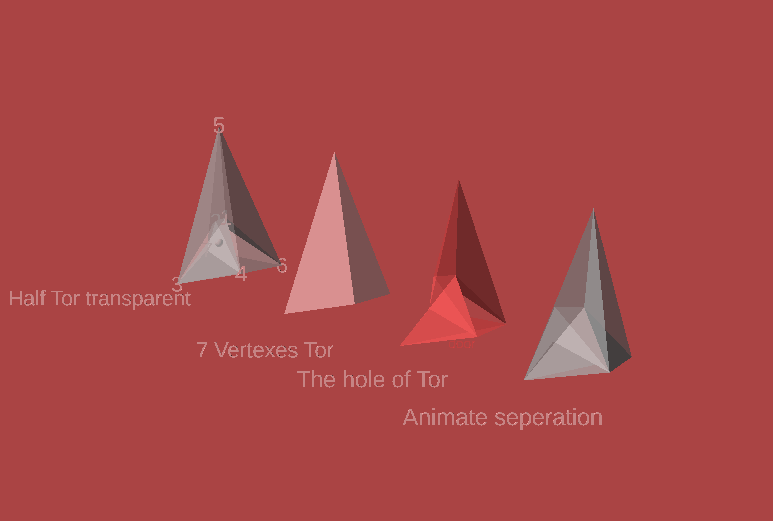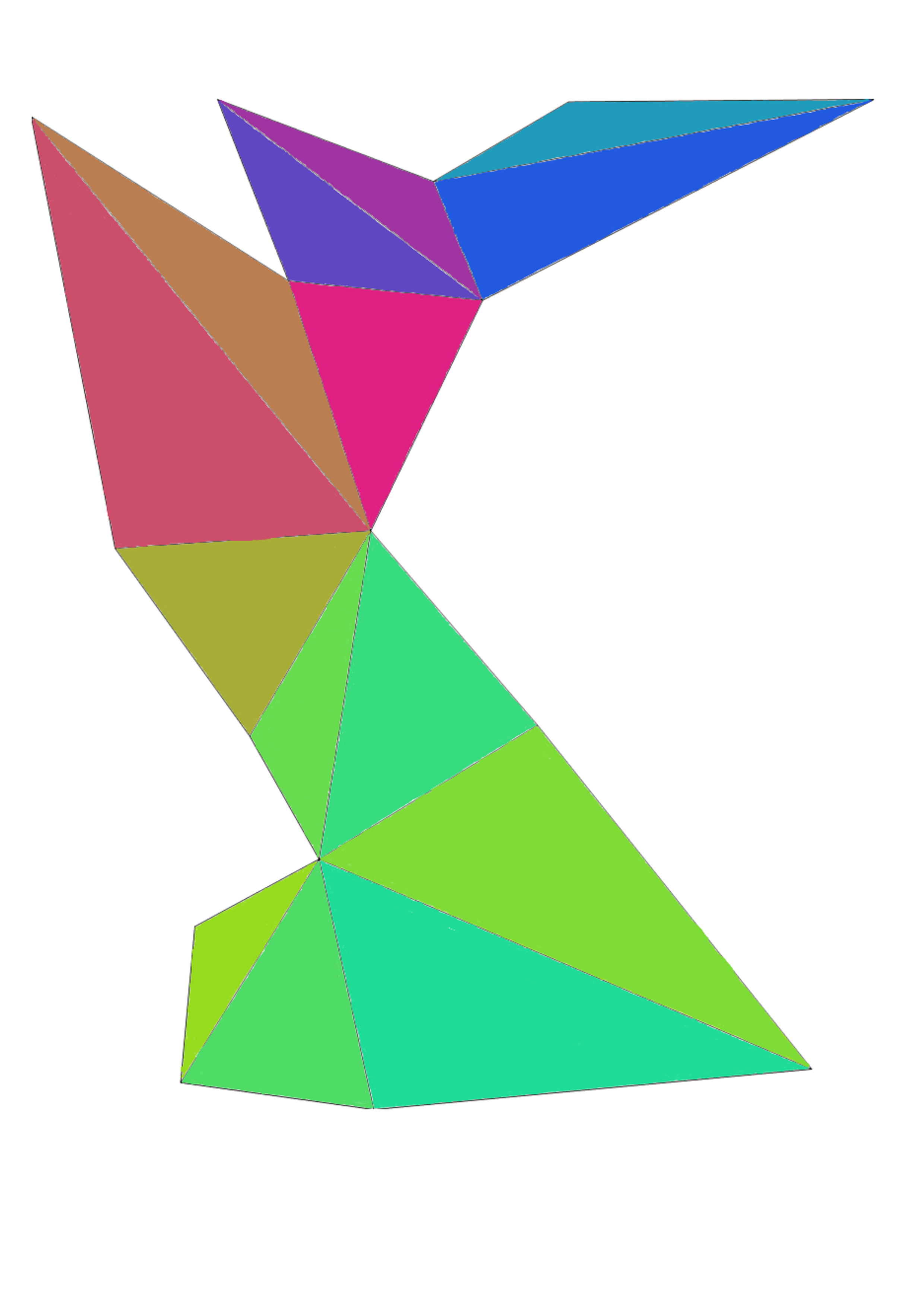The polyhedron with the minimum of vertices, which considers itself a doughnut
Looping breathing-and-separation animation of the Császár torus
Photo of paper Császár polyhedron

Animated Császár polyhedron

Paper cut unfold of a Császár polyhedron
The article is about Császár polyhedron.
(Its dual is the Szilassi polyhedron).
Tutorial
I was never able to construct Szilassi by myself, but there it follows how i constructed Császár polyhedron.
Algebraic start
The Euler characteristic X of a torus is zero.
So our torus has V-E+F=0, where V=vertices, E=edges and F=faces.
We can assume all faces are triangles. So, E=3F/2 (cause with 3F we count each edge twice).
So, V-3F/2+F=0 ==» F=2V and E=3V. Now from V vertices we can draw at most V*(V-1)/2 edges (if we connect all vertices each other). So, we want the minimum V where the inequality 2E<=V*(V-1) is true.
V |
E=3V |
F=2V |
2E |
V(V-1) |
||
|---|---|---|---|---|---|---|
| 0 | 0 | 0 | 0 | 0 | TRUE | It’s ok but we are not interesting in constructing nothing |
| 1 | 3 | 2 | 6 | 0 | False | because !(6<=0) |
| 2 | 6 | 4 | 12 | 2 | False | because !(12<=2) |
| 3 | 9 | 6 | 18 | 6 | False | because !(18<=6) |
| 4 | 12 | 8 | 24 | 12 | False | because !(24<=12) |
| 5 | 15 | 10 | 30 | 20 | False | because !(30<=20) |
| 6 | 18 | 12 | 36 | 30 | False | because !(36<=30) |
| 7 | 21 | 14 | 42 | 42 | TRUE | because 42=42 |
So we seek a torus with 7 vertices, 21 edges and 14 faces.
Topology
If we properly cut and stretch torus, we can have a cylinder. If we cut, through edge, the cylinder and unfold it, we have a rectangle plane, that reminds the screen of old pc games, where whatever goes up the screen appears down and whatever goes through a side appears entering from opposite site.
It’s more easy, having the above in mind to sketch the topology first. Remember left and right borders are the same, as it happens with up and down borders. So, i choosed an arbitrary one rectangle, placed, somehow arbitrary, the vertices and connected each vertex with all the others without intersections.
1-------2-------3-------1
| |
| |
4 4
| |
| |
5-------6-------7-------1
| | | |
| | | |
1-------2-------3-------1
I can not draw diagonal lines, so, except those seen above, with a pencil
- connect left 4 with upper 2
- connect left 4 with 6
- connect left 4 with 7
- connect upper 2 with 7
- connect upper 2 with 5
- connect upper 3 with 5
- connect upper 3 with left 4
- connect under-left 1 with 6
- connect under 3 with 6
- connect under-right 1 with 7
(There is a sketching try of topology far away from the objects)
Now, i imagine the triangles we see, as the interior faces of torus. With polyhedron command of openscad, IF we know the coordinates of vertices, is easy to construct the torus if we just notice that we should note triangles at counter-clock path subtracting 1 of the index.
Conclusions by this topology is that torus can be formed by 7 tetrahedrons that touch each other on 2 faces. So,
- the 236.7 tetraedron will join by 276 face with
- the 642.7 tetraedron, that will join by 624 face with
- the 642.1 tetraedron, that will join by 146 face with
- the 154.6 tetraedron, that will join by 145 face with
- the 154.3 tetraedron, that will join by 135 face with
- the 357.1 tetraedron, that will join by 357 face with
- the 357.2 tetraedron, that will join by 237 face with
- the initial 236.7 tetrahedron
From this, is obvious that when abc.d tetrahedron joins an abc.e one and (de) line must not intercept abc base, then d and e vertices must be one at each side of abc plan and at least one of them must be “outside” of abc triangle base.
(Hull and subtraction may be involved in seeking most beatiful torus)
Ignoring whatever involves vertex 5 in modeling tries, made me, somehow, understand the torus more easily. The third polyhedron is just the one easy command.
No, symmetry
Now, i would like to seek if there could be any kind of symmetry in this torus, to be more pretty and more “fat” with visible hole. (If i understood well, according to this, there is no symmetry. Even if vertices 1 and 7 could be manipulated so as to be symmetrical to axis through 5vertex as there are 6,3 and 2,4 vertices.)
Finish
That was my idea for tutorial, funny maybe for math interesting users. Seeking my own solution, by the help of openscad, was very fun. Without openscad, it would be very difficult to imagine what happens and see the harming intersections. The reward was great for me.
I believe, if two halves and the hole are printed seperately they will fit each other, but i’m not certain. Can’t use blender easily, so i can not put objects in some sceenes. Need to be commented all annotation and remove % and # modifiers for export stl to succeed. All design made for F5 and animation.
Thanks opescad irc members and teepee for encourage me.
Instructions
Since I have no printer, I uploaded it just for the fun of csg preview of openscad program. I would like to learn that someone printed a working puzzle either of the hole and two halves as easy or of 7 tetrahedrons 😄
Top, bottom, left, right, front, back orthogonal views with or without annimation seems pretty to me.
Ready solution
The openscad file is Császár-polyhedron.scad and blender file is pyramid-torus.blend.
Paper cut
Exporting stl file of the main solid to blender and using UVmaping I marked seam the 17,14,45,52,62,51,74,73 edges, unwraped and printed in paper. The unfold pattern in svg is here. Unfortunately, i didn’t print the final cut of paper with extented paper that used for glue.